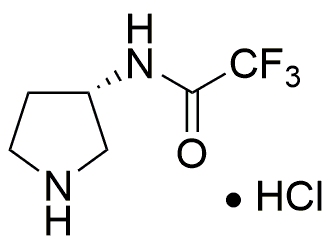(3S)-(-)-3-(Trifluoroacetamido)pyrrolidine hydrochloride is widely utilized in research focused on:
- Pharmaceutical Development: This compound serves as a key intermediate in the synthesis of various pharmaceuticals, particularly in the development of drugs targeting neurological disorders.
- Biochemical Research: It is used in studies exploring protein interactions and enzyme activity, helping researchers understand complex biological processes.
- Analytical Chemistry: The compound acts as a reagent in analytical methods, enhancing the detection and quantification of biomolecules in complex samples.
- Material Science: It finds applications in creating specialized polymers and materials, contributing to advancements in drug delivery systems and coatings.
- Agrochemical Formulations: This chemical is also explored in the formulation of agrochemicals, improving the efficacy and stability of pesticides and herbicides.
General Information
Properties
Safety and Regulations
Applications
(3S)-(-)-3-(Trifluoroacetamido)pyrrolidine hydrochloride is widely utilized in research focused on:
- Pharmaceutical Development: This compound serves as a key intermediate in the synthesis of various pharmaceuticals, particularly in the development of drugs targeting neurological disorders.
- Biochemical Research: It is used in studies exploring protein interactions and enzyme activity, helping researchers understand complex biological processes.
- Analytical Chemistry: The compound acts as a reagent in analytical methods, enhancing the detection and quantification of biomolecules in complex samples.
- Material Science: It finds applications in creating specialized polymers and materials, contributing to advancements in drug delivery systems and coatings.
- Agrochemical Formulations: This chemical is also explored in the formulation of agrochemicals, improving the efficacy and stability of pesticides and herbicides.
Documents
Safety Data Sheets (SDS)
The SDS provides comprehensive safety information on handling, storage, and disposal of the product.
Product Specification (PS)
The PS provides a comprehensive breakdown of the product’s properties, including chemical composition, physical state, purity, and storage requirements. It also details acceptable quality ranges and the product's intended applications.
Certificates of Analysis (COA)
Search for Certificates of Analysis (COA) by entering the products Lot Number. Lot and Batch Numbers can be found on a product’s label following the words ‘Lot’ or ‘Batch’.
*Catalog Number
*Lot Number
Certificates Of Origin (COO)
This COO confirms the country where the product was manufactured, and also details the materials and components used in it and whether it is derived from natural, synthetic, or other specific sources. This certificate may be required for customs, trade, and regulatory compliance.
*Catalog Number
*Lot Number
Safety Data Sheets (SDS)
The SDS provides comprehensive safety information on handling, storage, and disposal of the product.
DownloadProduct Specification (PS)
The PS provides a comprehensive breakdown of the product’s properties, including chemical composition, physical state, purity, and storage requirements. It also details acceptable quality ranges and the product's intended applications.
DownloadCertificates of Analysis (COA)
Search for Certificates of Analysis (COA) by entering the products Lot Number. Lot and Batch Numbers can be found on a product’s label following the words ‘Lot’ or ‘Batch’.
*Catalog Number
*Lot Number
Certificates Of Origin (COO)
This COO confirms the country where the product was manufactured, and also details the materials and components used in it and whether it is derived from natural, synthetic, or other specific sources. This certificate may be required for customs, trade, and regulatory compliance.


